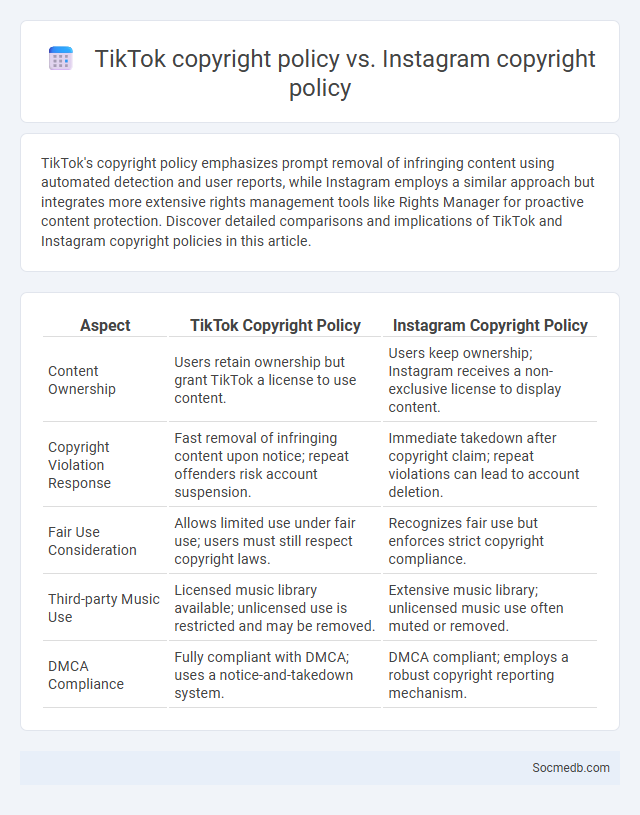
Photo illustration: TikTok copyright policy vs Instagram copyright policy
TikTok's copyright policy emphasizes prompt removal of infringing content using automated detection and user reports, while Instagram employs a similar approach but integrates more extensive rights management tools like Rights Manager for proactive content protection. Discover detailed comparisons and implications of TikTok and Instagram copyright policies in this article.
Table of Comparison
| Aspect | TikTok Copyright Policy | Instagram Copyright Policy |
|---|---|---|
| Content Ownership | Users retain ownership but grant TikTok a license to use content. | Users keep ownership; Instagram receives a non-exclusive license to display content. |
| Copyright Violation Response | Fast removal of infringing content upon notice; repeat offenders risk account suspension. | Immediate takedown after copyright claim; repeat violations can lead to account deletion. |
| Fair Use Consideration | Allows limited use under fair use; users must still respect copyright laws. | Recognizes fair use but enforces strict copyright compliance. |
| Third-party Music Use | Licensed music library available; unlicensed use is restricted and may be removed. | Extensive music library; unlicensed music use often muted or removed. |
| DMCA Compliance | Fully compliant with DMCA; uses a notice-and-takedown system. | DMCA compliant; employs a robust copyright reporting mechanism. |
Overview of TikTok and Instagram Copyright Policies
TikTok and Instagram enforce strict copyright policies to protect original content and intellectual property rights, utilizing automated systems and user reporting for infringement detection. You must ensure your posts do not violate copyright laws, as both platforms may remove unauthorized content and impose account penalties. Understanding their guidelines helps maintain your account's compliance while fostering a creative and lawful social media presence.
Key Differences Between TikTok and Instagram Copyright Rules
TikTok enforces stricter copyright policies by actively removing videos containing unlicensed music or copyrighted content, emphasizing original creations and licensed tracks, while Instagram offers more flexibility with its extensive music library and partnerships that allow broader use of copyrighted material. Your content on TikTok is often subject to automated copyright detection systems that can mute audio or block videos globally, whereas Instagram typically issues warnings or restricts reach but allows some copyrighted music use in Stories and Reels. Understanding these platform-specific copyright enforcement mechanisms ensures your social media strategy complies with legal standards and maximizes content visibility.
Procedures for Reporting Copyright Infringement on TikTok
To report copyright infringement on TikTok, you must provide a detailed takedown notice including your contact information, a clear description of the copyrighted work, and the URL of the infringing content. TikTok processes these reports in compliance with the Digital Millennium Copyright Act (DMCA), ensuring swift removal of content that violates copyright. Protect Your intellectual property by submitting accurate claims through TikTok's official copyright infringement form.
Procedures for Reporting Copyright Infringement on Instagram
Instagram's procedures for reporting copyright infringement involve submitting a formal complaint through the platform's dedicated Copyright Report form, which requires detailed information such as the nature of the copyrighted work, location of the infringing content, and a statement of good faith belief. Users must provide accurate contact information and a digital signature to validate the claim, ensuring the report aligns with the Digital Millennium Copyright Act (DMCA) guidelines. Following submission, Instagram reviews the claim and may remove or disable access to the infringing content to protect copyright holders' rights.
User Responsibilities and Copyright Compliance
Users on social media platforms must ensure they respect intellectual property rights by sharing content they own or have permission to use, adhering strictly to copyright laws to avoid infringement issues. Responsible behavior includes properly attributing original creators, avoiding unauthorized reposting of copyrighted materials, and reporting violations when encountered. Maintaining these standards helps protect creators' rights and fosters a respectful, legally compliant online community.
Content Removal and Appeal Processes Explained
Social media platforms implement content removal policies to address violations such as hate speech, misinformation, and copyright infringement, ensuring community standards are upheld. Users can appeal content removal decisions through designated review processes, often involving automated systems combined with human moderators. Transparent appeal workflows increase trust and allow for the reconsideration of content potentially removed in error.
Fair Use Considerations on TikTok vs Instagram
Fair Use considerations on TikTok and Instagram differ primarily due to platform content formats and user interaction styles. TikTok's short-form video content emphasizes transformative use, such as parody or commentary, whereas Instagram's diverse post types, including images and longer videos, require careful attribution and context for fair use claims. Content creators must evaluate the purpose, nature, and amount of material used on each platform to ensure compliance with copyright guidelines.
Penalties and Consequences for Copyright Violations
Social media platforms enforce strict penalties for copyright violations, including content removal, account suspension, and permanent bans to protect intellectual property rights. Copyright holders can issue Digital Millennium Copyright Act (DMCA) takedown notices that compel platforms to act swiftly, risking legal actions against persistent infringers. Platforms utilize automated detection systems and user reporting mechanisms to identify and manage unauthorized use, aiming to minimize infringement while safeguarding user experience.
How Platforms Detect Copyright Infringement
Social media platforms employ advanced content recognition technologies such as digital fingerprinting, watermark detection, and artificial intelligence algorithms to identify copyrighted material. These systems compare uploaded content against extensive databases of protected works to detect unauthorized use and flag potential violations. You can expect swift removal of infringing content and possible account penalties as platforms prioritize compliance with copyright laws.
Best Practices to Avoid Copyright Issues on Social Media
To avoid copyright issues on social media, you should always use original content or obtain proper licenses and permissions before sharing copyrighted materials such as images, videos, or music. Utilizing royalty-free or Creative Commons resources with clear attribution helps minimize legal risks and ensures your posts comply with platform policies. Monitoring your social media accounts regularly for unauthorized use of your content protects your intellectual property rights and maintains your online reputation.
 socmedb.com
socmedb.com